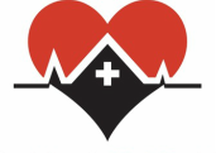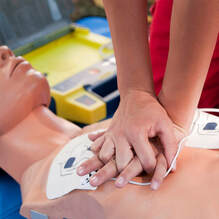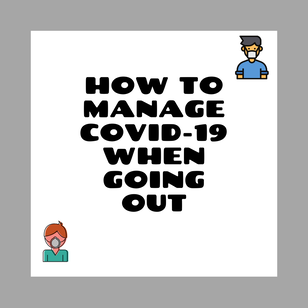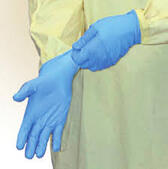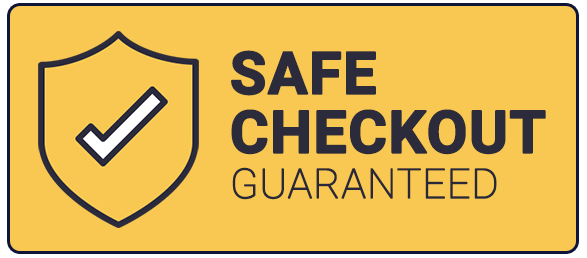STAYING CPR CERTIFIED DURING COVID-19With the global pandemic of COVID-19, now is the perfect time to learn CPR. Various hospitals worldwide are struggling with increasing patient volume, which means that people in everyday settings need to do their part to help “flatten the curve.” Sheltering in place is not the only method to stop the spread of coronavirus but it can also involve knowing how to administer life-saving skills such as CPR and First Aid. With proper aid at the scene of an emergency, the hospital space and time can be allocated to the outbreak, and many lives can be saved. If you are a healthcare provider or a laymen rescuer that has already been trained and certified in CPR, you can renew your BLS, ACLS, and/or PALS certification through completion of an online course and in-person skills testing and eliminate the additional time needed in the classroom. HEARTCODE BLS ONLINE & SKILLS CHECK Basic Life Support (BLS) is a certification course that teaches a number of live-saving skills. These include how to administer CPR to adults, children, and infants, how to operate in AEDs is a number of situations, how to assist choking victims, how to use breathing barriers and bag valve masks, and more. An accredited BLS certification is required for all medical care providers and first responders. Though it lasts just 2 years, it’s easy to renew. For those with an expired BLS certification card (or a card that will soon expire), our team here at Help-A-Heart CPR offers an Online BLS Renewal Course With Skills Check. This course requires participants to complete a series of self-paced online training modules that can take anywhere from 30 minutes to 2 hours to complete, depending on experience. Next, participants must complete a short skills test at our facility to be awarded a BLS certification renewal. This class is perfect for medical professionals with busy schedules and those looking to maintain safe social distances while allowing the first half of our BLS renewal course can be completed from the comfort of a home computer. The second part takes place in a clean, 1-on-1 environment with a trained emergency response professional. HEARTCODE ACLS ONLINE & SKILLS CHECK Advanced Cardiac Life Support (ACLS) is a certification course that builds upon the foundation laid by BLS and teaches more advanced life-saving skills. In addition to diving deeper into the subject matter covered in BLS courses, ACLS courses also cover how to properly administer an IV, how to read and decipher electrocardiograms, and how to administer emergency drugs. ACLS courses are designed specifically for medical professionals, including doctors, nurses, paramedics, anesthesiologists, dentists, and more. Like BLS certifications, accredited ACLS certifications last for 2 years. And like BLS certifications, they are easy to renew. Here at Help-A-Heart CPR, we are proud to provide an Online ACLS Renewal Course With Skills Check to help medical professionals renew their ACLS certifications without the additional complexity of lengthy class time. Like our BLS renewal course, this course requires participants to complete a series of self-paced online training modules that can take anywhere from 3 hours to 8 hours, depending on experience. Next, participants must complete a short skills test (lasting typically an 1 hour) in order to earn a renewal for their ACLS certifications. The first portion is can be completed from the comfort of your home, and the second portion is conducted in a sterile, 1-on-1 environment — great for medical professionals looking to stay safe during the coronavirus outbreak. HEARTCODE PALS ONLINE & SKILLS CHECK Pediatric Advanced Life Support (PALS) is a certification course created by the American Heart Association that teaches students how to administer life-saving care to children. PALS courses teach a systematic approach to Pediatric Assessment while helping students learn proper management of pediatric respiratory emergencies, safe vascular access, effective airway management, pharmacology, BLS for children, and more. PALS courses are required for professionals who provide medical to children of infants in emergencies. An accredited PALS certification lasts 2 years, but it can be renewed quickly without the need for a re-enrollment in an initial PALS certification course. Making it easy for emergency childcare professionals to renew their PALS certifications, our team here at Help-A-Heart CPR offers an Online PALS Renewal Course With Skills Check. Like the other renewal courses covered above, our PALS renewal course is completed in two sections. The first section includes a series of self-paced online training modules that participants can be completed in anywhere from 3 hours to 8 hours, depending on experience. The second section involves a short skills test (lasting anywhere from 30 minutes to 1 hour) that must be completed at a Help-A-Heart CPR facility in order for students to earn renewal for their PALS certifications. As mentioned above, our facilities are cleaned regularly and the skills test itself is conducted in a 1-on-1 environment for maximum safety. Even better: the online portion of our PALS renewal course can be completed from the comfort of your own home. WHY HELP-A-HEART CPR? In the midst of a pandemic, having essential emergency-response skills such as CPR and/or First Aid can help medical professionals and civilians save lives. Thankfully, you don’t have to put yourself at risk to renew your CPR certification. At Help-A-Heart CPR, we make it easy. Our renewal courses are completed mostly online, with only a short skills test conducted on-site at our clean, state-of-the-art facilities. There, you will receive 1-on-1 proctoring from one of our highly-skilled safety professionals. With the completion of ACLS or PALS you will also receive continuing education units to help with your professional license renewal requirements.
So, why choose us for CPR renewal? First, we create effective and engaging renewal courses that really work. With us, you gain skills that stick with you. Based in San Antonio, Texas we are fully endorsed by the American Heart Association and American Red Cross. Committed to excellence, we’ve helped further the careers of doctors, nurses, paramedics, childcare professionals, and countless civilians across our Central and South Texas community. Ready to take action? Contact our team to learn more about our award-winning courses and enroll with us.
Comments
Most states now have a “shelter in place” order due to the spread of COVID-19 otherwise known as the "coronavirus". However, individuals still need to leave their houses from time-to-time, whether it be grocery shopping, doctor’s visits, and/or the occasional walk around the neighborhood. Regardless, extra precautions must be followed. In this blog, we cover 3 tips to help you stay safe while on the go during COVID-19. Use these safety tips when grocery shopping, picking up essentials at other stores, or even going out for a walk around the neighborhood. 1. WEAR THE NECESSARY PERSONAL PROTECTIVE EQUIPMENT (PPE) While social distancing is important, it’s sometimes impossible to always follow. If you’re leaving your house, there will likely be moments when you will come closer than six feet away from another person. Whether it's at the grocery store, on a walks and/or runs, or even in your own home, you may need to interact with another person. In all of these situation, it is critical to wear one or several pieces of personal protective equipment (PPE). PPE consists of various items such as masks, gloves, gowns, and goggles. Each piece of PPE equipment serves as a protective barrier between your body and pathogens like COVID-19 which can spread through coughing, sneezing, or by touching one’s own eyes, mouth, or nose after touching a surface touched by an infected individual. Though each piece of PPE is important, not all pieces are always a necessity. Gloves, goggles, and gowns only need to be worn in and around confirmed COVID-19 patients in close quarters and should be reserved for healthcare providers if possible. However, one piece of PPE that should never be skipped is the mask. As modes of transmission for coronavirus are becoming better known and the rampant presence of asymptomatic carriers has become apparent, the CDC now recommends the use of cloth face masks outside of the home. 2. OBSERVE SOCIAL DISTANCING WHERE POSSIBLE Social distancing is now a necessary requirement when interacting with people outside your home. Based on CDC guidelines, social distancing involves maintaining a safe distance of at least 6 feet from anyone around you. The CDC has further suggested not to gather in large groups and staying out of any place that might be crowded. Due to these guidelines, many places of business that have to remain open including doctor’s offices, doctor's offices, autobody shops, and certain other retail location have implemented queues to allow only a few people into a property at once. Even with these guidelines in existence, it’s still important to observe social distancing both inside the store and outside. Perhaps try to structure your shopping experience based on the positions of other people in the store. For example, if someone is standing near a shelf or in a tightly confined aisle that you’re trying to access, wait and go to another area of the store. Lastly, when at checkout, always try to maintain a safe distance between others in line. 3. ALWAYS WASH YOUR HANDS Something as basic as washing your hands is a critical preventative measure against COVID-19. Washing your hands is important both before leaving your house and when returning. When you leave the house, your hands come into contact with many foreign objects such as groceries, door knobs, payment interfaces, bags, and more. Of course it is also vital to not touch your face if possible but even if you do manage to not touch your own face, you may touch other items in your home and spread the virus that way. So, you may ask "What’s the solution?" The answer is WASHING YOUR HANDS! After coming into contact with foreign objects, washing your hands can keep you from spreading contaminants to yourself or those around you. It is recommended to wash them the moment you get home after errands or if, you can, the moment you leave a store and again at home. If you can't wash your hands immediately then have a bottle of hand sanitizer easily accessible in your vehicle. So you might think that is an easy resolution. Not always. While you may consider yourself an obsessive hand-washer, you may be mistaken. Many people neglect to wash their hands thoroughly enough to remove harmful substances like bacteria, viruses, and other contaminants. Case in point-be mindful and make washing your hands a ritual or habit. These practices and more can help eliminate and/or reduce the potential to contract COVID-19. When it comes to stopping the spread of this deadly disease, staying home whenever possible is the way to go. Give us a call at Help-A-Heart CPR at 210-380-5344 for more information on preventing the spread of COVID-19.
COVID-19 OR THE "CORONAVIRUS AND PPE With the spread of “coronavirus” or COVID-19, a communicable viral disease; there has never been a better time to learn more about personal protective equipment (PPE). COVID-19 is passed from person to another through close contact and the sneezing or coughing of an infected person. Unfortunately, an individuals can also contract COVID-19 simply by touching a surface recently touched by an infected individual and then touching one’s own mouth, eyes, or nose. Transmitting and contracting COVID-19 can be greatly reduced by wearing personal protective equipment, which creates a barrier between the hands, the mouth, and other high-risk areas. Learn more about the different types of PPE and when to use in this valuable resource. WHEN SHOULD I USE PERSONAL PROTECTIVE EQUIPMENT (PPE)? So people often wonder when they should use personal protective equipment? Personal protective equipment may include gowns, goggles and face shields, gloves, and masks and respirators. This answer is really dependent on the personal or professional surrounding. Masks and respirators are used to cover the mouth and nose: high-risk areas for both contracting and transmitting sickness. Although the CDC recommendation is for voluntary use, an employer might feel it is critical to ensure certain employees do wear masks. If employees are considered “medium risk” for COVID-19 exposure because, for example, they have frequent contact with individuals within six feet, then using a mask may be required. Respirators cover as minimum the nose and mouth of users and remove contaminants from the air by filtering airborne particles or chemical agents from air. Goggles and face shields are designed to shield the eyes and the skin of the face, goggles and face shields are both extra protective layers designed to be worn in densely-populated areas with several contagious individuals. Disposable gloves are worn to protect the skin of the hands from pathogens and other harmful substances. However, even with COVID-19 in most countries and cities around the world, it’s not necessary to wear personal protective equipment at all times. If you are quarantining or practicing shelter in place, there is no need to wear protective equipment in your own home — provided you don’t live with anyone who has COVID-19. In most cases, it is only necessary to wear PPE when you are living or working in an enclosed space with COVID-19 patients. One notable additional case: if you are traveling and you have an existing respiratory condition, it is highly recommended that you wear a mask or respirator to prevent infection. Lastly, always remember to wash your hands with soap and water before putting on your PPE and after removing in order to prevent the cross-contamination of unwanted pathogens. To wash your hands properly, per the CDC guidelines, start by wetting both hands under warm water. Next, turn off the tap and apply soap. Lather all surfaces of your hands, including finger tips, creases between fingers, and the backs of your palms. Scrub for at least 20 seconds before turning the tap back on. LEARN MORE AND ENROLL IN LIFE-SAVING COURSES HERE AT HELP-A-HEART CPR Have more questions on how to put on personal protective equipment? Need extra guidance on how to remove personal protective equipment? Our team at Help-A-Heart CPR is here to help. Enroll in one of our many life-saving certification courses today! Contact us to get started at 210-380-5344.
IMPORTANCE OF CPR TRAINING FOR NEW MOMS!Being a new parent can be both exciting and stressful for a new mother. But how a new mother responds in an emergency is critical. Ideally, a new mother should be able to react quickly and effectively in any emergency and inadvertently avoid placing her child’s life in danger.
Across the United States, choking is a major problem among children across the United States. The American Heart Association (AHA) states over 90 percent of deaths due to foreign objects occur among children who are 5 years of age or younger, and 65 percent of these deaths take place among infants. If a child begins choking, how will the new mother respond? It is really dependent on the emergency training of the new parent. If the mother has received proper training she will know exactly what to do when her child begins choking. We all know that there is not a manual on being a new parent. However, new parents should always be prepared for the worst-case scenario. Many new mothers will take classes that provide insights into what to expect after a baby is born. While these classes often help new mothers plan ahead for life with a newborn; few new mom's enroll in training that teaches them how to administer cardiopulmonary resuscitation (CPR) to children and infants. CPR training is a necessary pre-requisite for a new mother. To better understand the critical nature of knowing CPR, consider the following statistics from UNICEF:
Participating in a CPR class usually only takes a few hours and the benefits of the class can last a lifetime. With CPR training, a new mother can gain the skills they need to administer life-saving assistance in many child, infant and adult emergencies. A CPR class will usually emphasizes three areas:
Help-A-Heart CPR classes represent ideal options for all members of the family. If a new mom and father want to take a CPR class together, we provide that option. Or, if a new mom wants to enroll in CPR training with grandparents, godparents, friends or anyone else, we have group training options to make it easy for everyone to earn their CPR certification at the same time. New moms who are seeking CPR training should consider any of the classes provided by Help-A-Heart CPR. To find out more about our CPR classes, please contact us today at 210-380-5344. |
AuthorDr. Tracy A. Jones is the CEO of Help-A-Heart CPR, LLC and an American Heart Association, ASHI, and American Red Cross Master Program Trainer, Instructor, & AHA Faculty Member located in San Antonio, Texas. Archives
June 2024
Categories |
Help-A-Heart CPR, LLC | 1747 Citadell Plaza Suite 101 | San Antonio, Texas 78209 | (210) 380-5344 | [email protected]
Copyright © Help-A-Heart CPR, LLC 2024
100% Certification Acceptance
We promise your employer, school, or agency will accept the certification card we issue to you. If there is a question of acceptance or validity, simply send us an email at [email protected] with full details. We will reach out to the individual/entity and provide accreditation information. If still there’s a question, we will provide you with a full refund of your class fee. It’s that simple.
We promise your employer, school, or agency will accept the certification card we issue to you. If there is a question of acceptance or validity, simply send us an email at [email protected] with full details. We will reach out to the individual/entity and provide accreditation information. If still there’s a question, we will provide you with a full refund of your class fee. It’s that simple.
|
Communities Served
ALABAMA: Birmingham
ARKANSAS: Fayetteville, Hot Springs, Jonesboro, Little Rock NEW MEXICO: Albuquerque TENNESSEE: Knoxville TEXAS: Amarillo, Arlington, Austin, Bandera, Bastrop, Boerne, Brownsville, Comfort, Converse, Corpus Christi, Dallas/Ft. Worth, Del Rio, Dripping Springs, El Paso, Floresville, Fredericksburg, Georgetown, Harlingen, Houston, Junction, Katy, Kerrville, Kingsville, Kingwood, Laredo, Lubbock, Lufkin, McAllen, Midland, New Braunfels, Odessa, Pleasanton, Round Rock, San Angelo, San Marcos, Schertz, Seguin, Taylor, Temple, Texarkana, Tyler, Universal City, Victoria, Waco, The Woodlands |
Why Choose Help-A-Heart CPR?
1. Flexible Scheduling
2. On and Off Location Training Available 3. Casual, Fun Atmosphere 4. Best Price Guarantee 5. All Instructors are AHA and/or ARC certified 6. 5 Star Google Reviews 7. Blended Learning (Online & Skills Check) Available 8. Meets OSHA & College CPR Requirements 9. Get Certified Within 3-4 Hours 10.Certification Is Good For Two Years 11. Official AHA/ARC/ASHI Training Site 12. High Quality Safety Training! |
